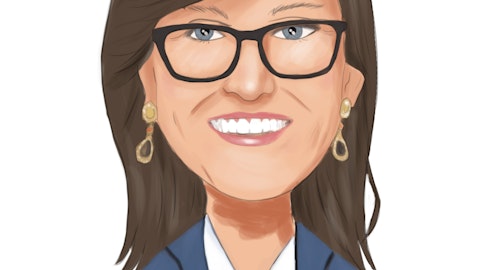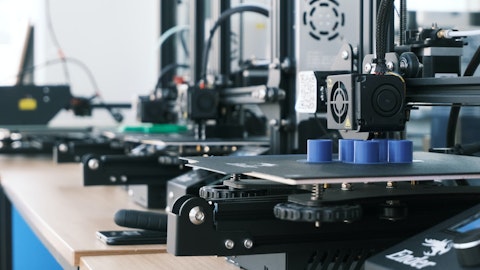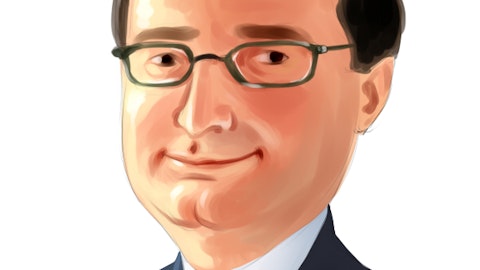Tyler Radke: That’s super clear. Thank you. And just a follow-up, so going back to one of the questions on the competition, maybe broader than just what you’re seeing as it relates to SaaS. Can you just talk about maybe the strength you’re seeing in PLM more broadly? And obviously the growth rates you’re posting on an organic basis are kind of above market. Who do you see you’re taking share from and anything from a product perspective you’d highlight?
Jim Heppelmann: Yes. I mean nothing changed materially in the quarter. But to kind of remind you, just in general what’s happening. SAP has given up share, Oracle has given up share. In our view, Dassault has given up quite a bit of share, because we passed them in the last year and we’re opening up quite a gap now. And we think Siemens has given up some share. Siemens has been posting actually negative numbers in terms of PLM growth of late, and it will be interesting to see at the next earnings report. I encourage you all to dig in and try to parse it apart, because I think Siemens is losing a lot of momentum. They have some structural changes happening, so it’s a little hard to kind of tease it all out and they don’t provide much disclosure.
But I think you’re going to see — Siemens would be our toughest competitor and you’re going to see us post growth rates approaching 20% and it wouldn’t surprise me if theirs has a negative number on the front of it when they report this quarter.
Tyler Radke: Thank you.
Operator: And your next question comes from the line of Steve Tusa from JPMorgan. Your line is open.
Jim Heppelmann: Hi, Steve.
Steve Tusa: Hey, guys. Thanks for taking my questions. Sorry, I’m kind of new to covering you guys and so the math maybe is a little bit tricky. But like you said last quarter that I think it was a low-single-digit constant currency bookings growth year-over-year. I’m kind of having trouble putting what you just said kind of altogether. What does that actually mean on a year-over-year constant currency bookings growth rate for this quarter?
Jim Heppelmann: Yes. Steve, I mean we don’t disclose. We don’t report bookings. We don’t guide bookings. We provide color. And because, again, the scenario was a little strange compared to the guidance scenarios, softer on bookings, stronger on free cash flow to avoid having to disclose a lot more detail, we netted it out and netted it out as better than guidance but a slowdown of about $8 million for the year 0.5 percentage point.
Steve Tusa: Yes. Okay, got it. That’s helpful. And then just lastly on free cash flow, pretty strong even seasonally even how you talk about it with a decent amount coming here in the first half of the year assuming you hit the $200 million. Receivables were a big positive at least on a GAAP basis. Anything else moving around in working capital that kind of overdrove at all or is this kind of bang in line with what you guys were expecting?
Kristian Talvitie: In general, I think it was largely in line with what we were expecting Steve. I mean again solid collections performance.
Steve Tusa: Yeah. Okay.
Jim Heppelmann: Yes, it’s little bit Steve, like with the ARR situation where our guidance contains a little bit of a buffer and we didn’t need it.
Steve Tusa: Yes. Congrats on the good result. Thanks.
Jim Heppelmann: Great. Thank you.
Operator: Your next question comes from the line of Saket Kalia from Barclays. Your line is open.
Jim Heppelmann: Hello, Saket.
Saket Kalia: Hey, Jim. Hey, Kristian. Thanks for taking my question here. Jim, maybe just — I’d love to dig one level deeper just into sort of that dichotomy, right, the softer bookings but then also the lower churn. Maybe just on the softer bookings piece, are those deals that are pushing? Are those deals that are still in the pipeline, or are they ones that you think just get pushed indefinitely? And then on the lower churn piece, that is great to hear, particularly with the hiring environment how much is maybe some of the price adjustments that we did last year maybe factoring into that as well?
Jim Heppelmann: Yes. Well, let me address the churn piece first and I’ll circle back to the push or cancellation on bookings. On churn, you remember that we gave you scenarios that had churn getting worse, when we were clear, we have no evidence that that is happening or will happen, it just seems prudent to allow for the possibility. So, we’re allowing for a possibility that would require a reversal in trend, but we did not get the reversal in trend. We got actually more of the same improving trend. And I think we were clear that certainly pricing helps, but it doesn’t really account for the strength we’re seeing. I mean the strength we’re seeing is fundamentally just good renewals. And to put it in perspective, Creo and Windchill, represent roughly 70% of our ARR just those two products.
And if you took the churn rate for Creo and Windchill in the quarter and you annualized it for the entire year, it would be less than 3% churn on those two massive product bases. So I mean, we’re talking about fundamentally strong adoption of our technology, mission-critical technology. You can’t switch from it. You can’t stop using it. You can’t stop paying for it, I mean unless you’re winding your business down. So, I think it’s just good fundamental sticky software that people are continuing to use. And I think there’s not really a lot of layoffs happening in our marketplace right now our customers. A lot of layoffs happening in tech, but I don’t think so many engineers in the world of product development for physical products are getting laid off.
And then coming back to the push and cancel, I mean, I think it’s mostly push. What happens is typically you’ve got a purchase order and it needs some level of approval. Maybe last quarter, it needed a higher level of approval, another signature maybe somebody sat on that signature because they’re saying, couldn’t we do this next quarter? Couldn’t we start this project a little later? So I think it’s pushing. There’s no competitive dynamics. And generally it’s not being canceled, because companies do need this technology. They’re just delaying a little bit. The second factor would be expansion, sometimes are driven by hiring. If a company is hiring a lot of engineers, well, now they need to go back and buy more CAD and PLM seats for those engineers.
There probably is a slowdown in hiring, which is slowing down expansions, but nothing structural happening. It’s just sort of the natural delays the cholesterol if you will that gets in the way of doing deals when people are getting nervous about the economy.
Saket Kalia: Makes a lot of sense. Thanks, Jim.
Operator: Your next question comes from the line of Jay Vleeschhouwer from Griffin Securities. Your line is open.
Jay Vleeschhouwer: Thank you. Good evening. Jim for you first, over the last couple of years at least to the active bases for both Creo and Windchill have seemingly grown at least a mid-single-digit rate, at least by our calculation, which corresponds to the share gain for each we’ve been able to document. How are you thinking about the active base growth from here for both those products? And perhaps more broadly, since we’ve gone through so many evolutions of both those markets over the last many years, what from here do you think are the critical functionalities within CAD and PLM to continue or sustain the growth in those businesses, maybe GD or something else that you care to mention? And then secondly, maybe for Kristian you’ve done well in terms of product releases, adhering to the road map, but you do have the smallest R&D budget in your peer group.
So, how are you thinking about orchestrating or managing R&D productivity from here to keep executing on that road map in the context of containing your expenses?





